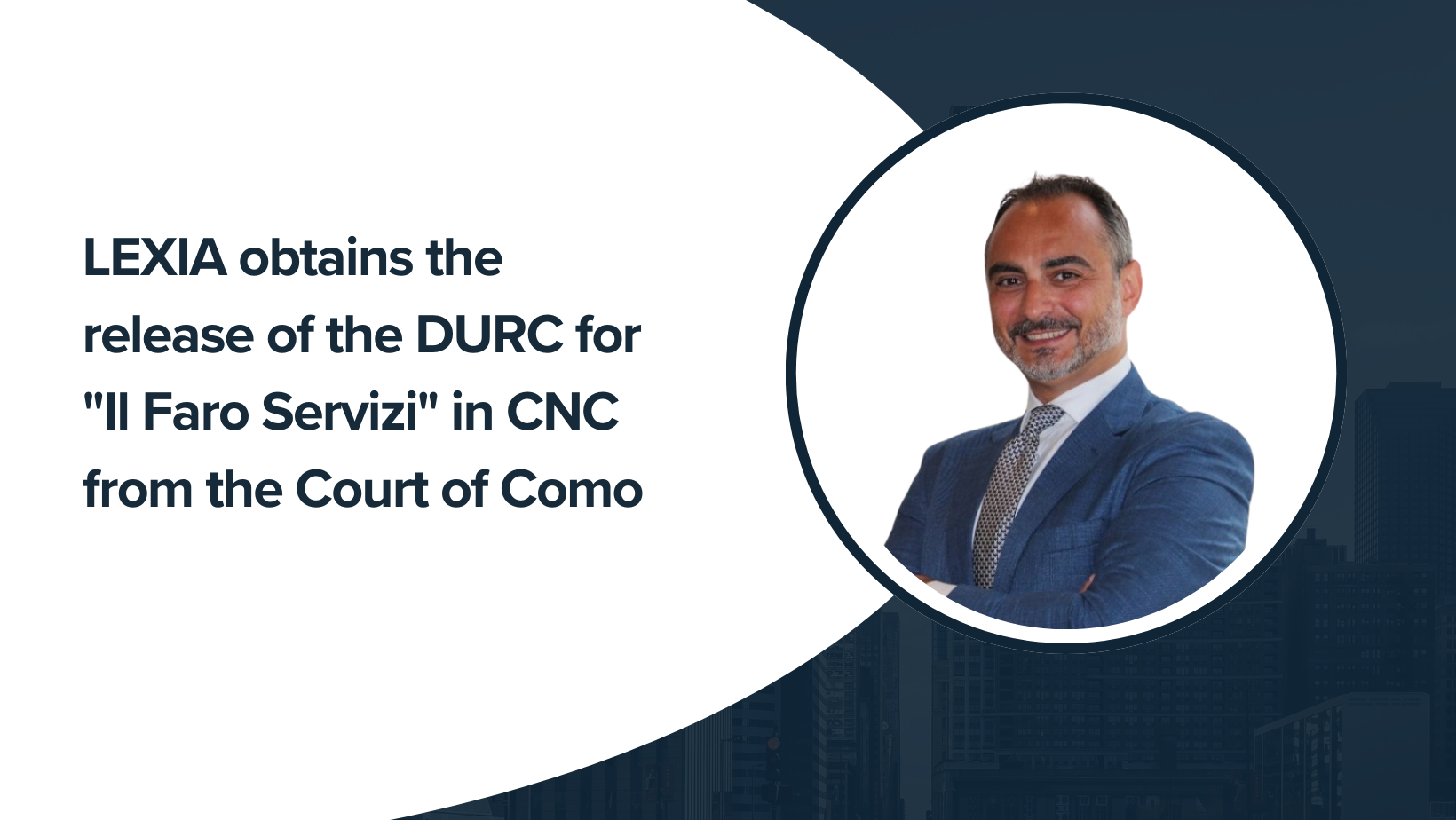On September 27, 2024, Legislative Decree No. 136 of September 13, 2024 («Correttivo-ter») was published in the Official Gazette. This is the third—and currently final—Corrective Decree to the Code of Business Crisis and Insolvency.
The new corrective decree has made substantial changes to all aspects of the Crisis Code. Beyond numerous stylistic and detailed adjustments, the Correttivo-ter both incorporates certain practices or resolves interpretative uncertainties and introduces several long-awaited innovations for practitioners.
This article aims to provide an overview of the major changes introduced by the Correttivo to the Negotiated Composition of Business Crisis (“CNC”).
THE NEGOTIATED COMPOSITION OF BUSINESS CRISIS (CNC)
The Negotiated Composition of Business Crisis (“CNC”) is a pathway established by the legislature for debt restructuring and is among the mechanisms that have most benefited from the changes introduced by the new corrective decree.
The first modification involved Article 12, which now allows entrepreneurs to use the Negotiated Composition in any situation their business is facing—whether the business is in crisis, insolvent, or, uniquely compared to other crisis management tools, even when it is merely experiencing a state of asset or financial imbalance.
The legislature aimed to clarify interpretative uncertainties in this area by broadening the eligibility criteria for accessing the Negotiated Composition. Previously, it was not conceived as an option in cases of declared insolvency under Article 2, letter b), of the Business Crisis and Insolvency Code (CCI).
The rationale behind this change is also tied to the legislature’s intent to encourage the entrepreneurial community to make greater use of this tool.
Amendments have also been made to the documentation requirements under Article 17, which businesses must submit alongside their application for access to the CNC. These changes are detailed below.
Among the updates is the introduction of letter a-bis to Article 17, paragraph 3. This addition aims to facilitate access to the Negotiated Composition even when financial statements have not been duly approved. Entrepreneurs are now allowed to include draft financial statements with their application or, if unavailable, an updated economic, asset, and financial statement prepared within 60 days prior to filing the application.
Letter d has also been revised to resolve an interpretative issue raised by case law, where some rulings had denied access to the Negotiated Composition when a judicial liquidation application was pending. The noble goal pursued by the Correttivo is clearly outlined in the Explanatory Report, which states:
«When applying for the composition, the entrepreneur must certify that they have not filed for access to another crisis or insolvency management tool. However, with regard to judicial liquidation, they must only declare whether any proceedings are pending, without affirming their absence. The incompatibility between negotiated composition and judicial tools […] stems from the decision not to allow extrajudicial pathways to businesses that have previously chosen to pursue recovery through judicial proceedings. This provision is justified by the desire to prevent dilatory or abusive behavior by those seeking the composition solely to evade the potential consequences of the crisis and insolvency tools they have already opted for.»
On this matter, the amendment to Article 25-quinquies has also aided interpreters. Its new configuration, coordinated with the aforementioned changes, seeks to end the debate about the possibility of accessing the Negotiated Composition while a judicial liquidation application is pending. It clarifies the legislature’s intent to prohibit the extrajudicial resolution of a crisis via the Negotiated Composition only when the entrepreneur has already initiated a judicial restructuring process (e.g., preventive arrangements, restructuring agreements, or a court-approved restructuring plan). However, this restriction does not apply when a judicial liquidation request is filed by a creditor, the public prosecutor, or administrative bodies and authorities responsible for oversight and supervision of the business.
Additionally, the legislature introduced the new paragraph 3-bis, which reduces the documentation required. Specifically, it alleviates the need for certifications attesting to tax, contribution, and social security debts, given the often lengthy process of obtaining such documents. To address this, the Correttivo formalized the practice already adopted by entrepreneurs, allowing them to prove that they have requested these documents at least ten days before submitting their application for the appointment of an expert.
Through these modifications, the Correttivo-ter aims to encourage greater use of the Negotiated Composition tool by reducing the rigidity of the documentation requirements attached to the application. At the same time, it establishes limits to its use to prevent potential abuses.
Numerous changes have also been made regarding relations with banking institutions.
Concerning pending contracts, banking creditors are now explicitly included among those subject to the provisions, resolving interpretative conflicts about whether banking institutions fall within the rules on granting protective measures. Additionally, it addresses the relationship between (i) Article 16, paragraph 5, which specifically pertains to dealings with banking institutions, and (ii) Article 18, paragraph 5, a general provision applying indiscriminately to all creditors.
With regard to the access phase to the Negotiated Composition for Business Crisis (CNC), a corrective measure has amended Article 17, introducing a requirement for institutional creditors who suspend or, in more severe cases, revoke credit lines granted to entrepreneurs to explicitly justify the reasons behind their decision. Specifically, the continuation of the credit relationship cannot be considered a basis for liability “per se,” nor can the mere news of CNC access be a sufficient reason to reclassify the credit. Such evaluations must instead be made on a case-by-case basis.
Additionally, Article 18, paragraph 5-bis, has been amended to establish the obligation to reactivate suspended credit lines following the request for protective measures if such measures are confirmed. This obligation applies to affected entities, including banks, financial intermediaries, trustees, and securitization vehicles, while still allowing suspensions to continue under prudential supervision regulations.
The above-mentioned amendments address a dual objective. On one hand, they protect the entrepreneur from risks to business continuity arising from the revocation of banking facilities or the reclassification of existing credit lines to non-performing loans, along with the potential negative effects of reporting to the Credit Bureau (Centrale Rischi). On the other hand, they reduce the risk for banks of being presumed liable for delays in suspending or revoking credit lines, thereby minimizing exposure to claims of abusive lending practices. By doing so, the legislation ensures a balanced protection of the interests at stake.
The role of the Expert has also benefited from the amendments introduced by the Corrective Measures (Correttivo-ter). The Legislator, in addition to updating the criteria for the Expert’s appointment, sought to facilitate the continuation of their mandate beyond the initial 180 days, as provided under Article 17, for an additional 180 days. This extension is conditional upon two scenarios: either the entrepreneur or the negotiating parties, with the Expert’s consent, explicitly request it, or, in the absence of such a request, protective or precautionary measures are ongoing, an application has been filed with the court, authorization under Article 22 is pending, or the related measure is to be implemented. The Explanatory Report highlights that the continuation of the Expert’s mandate is linked not only to the pendency of judicial proceedings but also to the necessity of implementing measures granted to ensure the successful outcome of ongoing negotiations.
Significant amendments have also been made regarding protective and precautionary measures. The corrective intervention, aligning with the prevailing judicial interpretation, amended Article 18, paragraph 1, allowing entrepreneurs to request these measures concurrently with the application for the Expert’s appointment. The protective measures can be tailored to the entrepreneur’s needs, targeting either the entire creditor class, specific categories (e.g., banks), or individual creditors, such as one who has initiated or is conducting enforcement proceedings against the debtor. Additionally, Article 18, paragraph 3 clarifies that protective measures not only suspend executive or precautionary activities but also prohibit the acquisition of unapproved preferential rights and suspend prescription periods and deadlines, as referenced in Article 54, paragraph 2.
The Corrective Measures introduced significant changes to the application process for protective measures to align it with its urgent nature. Under Article 19, paragraph 1, videoconferencing is now the preferred method for hearings on protective measures. Furthermore, the decree scheduling the hearing must be published in the Business Register, and the court may adopt ad hoc notification methods. These adjustments address practical challenges in cases involving numerous creditors, ensuring the timely and effective implementation of measures. The rationale behind these amendments lies in reconciling the short timelines set by the Code for scheduling hearings with the need to uphold the principle of adversarial proceedings, particularly in cases involving a large number of creditors.
Amendments to Article 22 introduced significant clarity regarding prededuction. The tribunal’s prior authorization for contracting financing, issuing guarantees, or concluding agreements to reactivate suspended credit lines is now explicitly required for prededuction purposes. Two new paragraphs have also been added: Paragraph 1-bis specifies that the implementation of the authorized measures may occur during or after the CNC process, provided they are approved by the tribunal or indicated in the final report. Paragraph 1-ter establishes that prededuction applies irrespective of the CNC’s outcome, within enforcement or insolvency proceedings, and remains valid in cases of consecutive procedures.
One of the most innovative amendments to the CNC is the introduction of the tax settlement mechanism under Article 23, paragraph 2-bis, without the cram-down procedure. Entrepreneurs can now propose agreements to the Revenue Agency for the partial or deferred payment of tax debts, excluding EU resource taxes. Execution of the agreement is subject to judicial authorization, contingent upon verifying the formalities and supporting documentation. If approved, the agreement is automatically void should the entrepreneur fail to comply fully, or if judicial liquidation, controlled liquidation, or a declaration of insolvency occurs within 60 days of the agreed deadlines.
These amendments aim to enhance the CNC’s effectiveness by fostering greater flexibility while maintaining adequate safeguards. By addressing the role of the Expert, clarifying procedural requirements for protective measures, and introducing the tax settlement mechanism, the Corrective Measures ensure a balanced and pragmatic approach to business crisis management.






